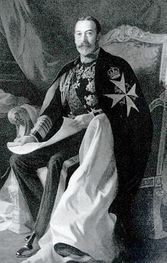Empire
The term empire derives from the Latin imperium. Politically, an empire is a geographically extensive group of states and peoples (ethnic groups) united and ruled either by a monarch (emperor, empress) or an oligarchy. Geopolitically, the term empire has denoted very different, territorially-extreme states — at the strong end, the extensive Spanish Empire (16th c.) and the British Empire (19th c.), at the weak end, the Holy Roman Empire (8th c.–19th c.), in its Medieval and early-modern forms, and the Byzantine Empire (15th c.), that was a direct continuation of the Roman Empire, that, in its final century of existence, was more a city-state than a territorial empire.
Etymologically, the political usage of “empire” denotes a strong, centrally-controlled nation-state, but, in the looser, quotidian, vernacular usage, it denotes a large-scale business enterprise (i.e. a transnational corporation) and a political organisation of either national-, regional- or city scale, controlled either by a person (a political boss) or a group authority (political bosses).[1]
An imperial political structure is established and maintained two ways: (i) as a territorial empire of direct conquest and control with force (direct, physical action to compel the emperor’s goals), and (ii) as a coercive, hegemonic empire of indirect conquest and control with power (the perception that the emperor can physically enforce his desired goals). The former provides greater tribute and direct political control, yet limits further expansion because it absorbs military forces to fixed garrisons. The latter provides less tribute and indirect control, but avails military forces for further expansion.[2] Territorial empires (e.g. the Mongol Empire, the Median Empire) tended to be contiguous areas. The term on occasion has been applied to maritime empires or thalassocracies, (e.g. the Athenian, the British Empire) with looser structures and more scattered territories.
Contents |
Definition
An empire is a state with politico-military dominion of populations who are culturally and ethnically distinct from the imperial (ruling) ethnic group and its culture[3] — unlike a federation, an extensive state voluntarily composed of autonomous states and peoples. As a state, an empire may be either territorial or a hegemony, wherein the empire’s sphere of influence dominates the lesser state(s) via divide and conquer tactics, i.e. “the enemy of my enemy is my friend”, (cf. superpower, hyperpower).
What physically and politically constitutes an empire is variously defined. It might be a state effecting imperial policies, or a particular political structure. Sometimes an empire is a semantic construction, such as when a ruler assumes the title of “Emperor”. The said ruler's nation logically becomes an “Empire”, despite having no additional territory or hegemony such as Central African Empire or the Korean Empire proclaimed in 1897 when Korea, far from gaining new territory, was on the verge of being annexed by Japan. The terrestrial empire’s maritime analogue is the thalassocracy, an empire comprising islands and coasts which are accessible to its terrestrial homeland, such as the Athenian-dominated Delian League.
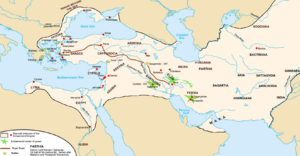
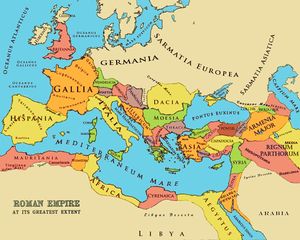
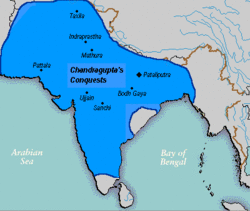
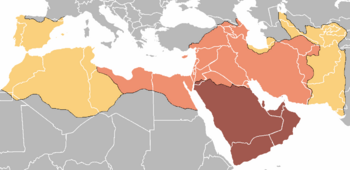

History of Imperialism
Early empires
The Akkadian Empire of Sargon the Great (24th century BC), was an early large empire. In the 15th century BC, the New Kingdom of Ancient Egypt, ruled by Thutmose III, was ancient Africa’s major force upon incorporating Nubia and the ancient city-states of the Levant. The first empire, comparable to Rome in organization, was the Assyrian empire (2000–612 BC). The successful, extensive, and multi-cultural empire that was the Persian Achaemenid Empire (550–330 BC), absorbed Mesopotamia, Egypt, part of Greece, Thrace, the rest of the Middle East, much of Central Asia, and Northwest India (Presently Pakistan).
The Maurya Empire was a geographically extensive and powerful empire in ancient India, ruled by the Mauryan dynasty from 321 to 185 BC. The Empire was founded in 322 BC by Chandragupta Maurya and rapidly expanded his power westwards across central and western India taking advantage of the disruptions of local powers in the wake of the withdrawal westward by Alexander the Great Greek and Persian armies. By 320 BC the empire had fully occupied Northwestern India till Afghanistan, defeating and conquering the satraps left by Alexander.
Classical period
The Roman Empire was the most extensive Western empire until the early modern period. Prior to the Roman Empire the kingdom of Macedonia, under Alexander the Great, became an empire that spanned from Greece to Northwest India. After Alexander's death, his empire fractured into four, discrete kingdoms ruled by the Diadochi, which, despite being independent, are denoted as the "Hellenistic Empire". In the East, the term Persian Empire denotes the Iranian imperial states established at different historical periods of pre–Islamic and post–Islamic Persia. And in the Far East, various Celestial Empires arose periodically in East Asia between periods of war, civil war, and foreign conquests. In India Chandragupta expanded the Mauryan Empire to Northwest India (Modern day Pakistan and Afghanistan). This also included the era of expansion of Buddhism under Ashoka the Great. In China the Han Empire became one of East Asia's most long lived dynasties, but was preceded by the short-lived Qin Empire.
Post classical period
The 7th century saw the emergence of the Islamic Empire, also referred to as the Arab Empire. The Rashidun Caliphate expanded from the Arabian Peninsula and swiftly conquered the Persian Empire and much of the Byzantine Roman Empire. Its successor state, the Umayyad Caliphate, expanded across North Africa and into the Iberian Peninsula. By the beginning of the 8th century, it had become the largest empire in history at that point, until it was eventually surpassed in size by the Mongol Empire in the 13th century. In 7th century Maritime Southeast Asia witnessed the rise of a Buddhist thallasocracy of Srivijaya Empire, thrive for 700 years, and successed by Hindu-Buddhist Majapahit Empire in 13th to 15th century. In Southeast Asian mainland, Hindu-Buddhist Khmer Empire built an empire centered in the city of Angkor flourished from 9th to 13th century.
At the time, in the Medieval West, the title “empire” had a specific technical meaning that was exclusively applied to states that considered themselves the heirs and successors of the Roman Empire, e.g. the Byzantine Empire, the Carolingian Empire, the largely Germanic Holy Roman Empire, the Russian Empire, yet these states were not always technically — geographic, political, military — empires in the modern sense of the word. To legitimise their imperium, these states directly claimed the title of Empire from Rome. The sacrum Romanum imperium (Holy Roman Empire) of 800 to 1806, claimed to have exclusively comprehended Christian principalities, and was only nominally a discrete imperial state. The Holy Roman Empire was not always centrally-governed, as it had neither core nor peripheral territories, and was not governed by a central, politico-military élite — hence, Voltaire’s remark that the Holy Roman Empire “was neither holy, nor Roman, nor an empire” is accurate to the degree that it ignores[4] German rule over Italian, French, Provençal, Polish, Flemish, Dutch, and Bohemian populations, and the efforts of the eighth-century Holy Roman Emperors (i.e. the Ottonians) to establish central control; thus, Voltaire’s “. . . nor an empire” observation applies to its late period.
In 1204, after the Fourth Crusade sacked Constantinople, the crusaders established a Latin Empire (1204–1261) in that city, while the defeated Byzantine Empire’s descendants established two, smaller, short-lived empires in Asia Minor: the Empire of Nicaea (1204–1261) and the Empire of Trebizond (1204–1461). Constantinople was retaken by the Byzantine successor state centered in Nicaea in 1261, re-establishing the Byzantine Empire until 1453, by which time the Muslim Ottoman Empire (ca.1300–1918), had conquered most of the region. Moreover, Eastern Orthodox imperialism was not re-established until the coronation, in 1682, of Peter the Great as Emperor of Russia. Like-wise, with the collapse of the Holy Roman Empire, in 1806, during the Napoleonic Wars (1803–1815), the Austrian Empire (1804-1867), emerged reconstituted as the Empire of Austria–Hungary (1867–1918), having “inherited” the imperium of Central and Western Europe from the losers of said wars.
The Mongol Empire, under Genghis Khan in the thirteenth century, was forged as the largest contiguous empire in the world. Genghis Khan's grandson, Kublai Khan, was proclaimed emperor, and established his imperial capital at Beijing; however, in his reign, the empire became fractured into four, discrete khanates.
Colonial empires
European landings in the so-called "New World" (first, the Americas and later, Australasia) in the 15th century, proved ripe opportunities for the continent's Renaissance-era monarchies to launch colonial empires like those of the ancient Romans and Carthaginians. In the "Old World", colonial imperialism was attempted, effected and established upon the Canary Islands and Ireland. These conquered lands and peoples became de jure subordinates of the empire, rather than de facto imperial territory and subjects. Such subjugation often elicited “client-state” resentment that the empire unwisely ignored, leading to the collapse of the European colonial imperial system in the late-19th century and the early- and mid-20th century.
Modern period


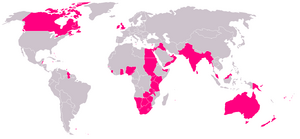
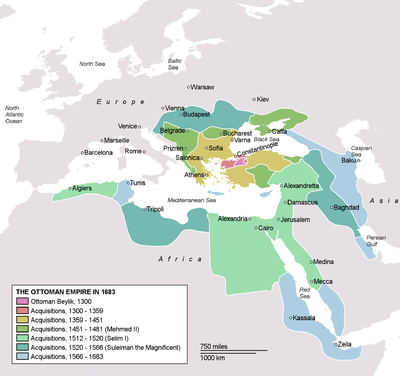
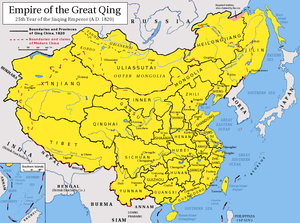
In general governments styled themselves as having greater size, scope and power than the territorial, politico-military and economic facts allow. As a consequence some monarchs assumed the title of “emperor” (or its corresponding translation: tsar, empereur, kaiser, etc.) and renamed their states as “The Empire of . . . ”.
The French emperors Napoleon I and Napoleon III (See: Second Mexican Empire [1864–1867]) each attempted establishing a western imperial hegemony based in France. The German Empire (1871–1918), another “heir to the Holy Roman Empire” arose in 1871. Europeans began applying the name of “empire” to non-European monarchies, such as the Qing Dynasty and the Mughal Empire, and then leading, eventually, to the looser denotations applicable to any political structure meeting the criteria of imperium.
Empires accreted to different types of states, although they traditionally originated as powerful monarchies. The Athenian Empire, the Roman Empire and the British Empire developed under elective auspices. The Brazilian Empire declared itself an empire after breaking from the Portuguese Empire in 1822. France has twice transited from being called the French Republic to being called the French Empire, while France remained an overseas empire. To date it still governs colonies (French Guyana, Martinique, Réunion, French Polynesia, New Caledonia) and exerts an hegemony in Francophone Africa (Chad, Rwanda, et cetera).
Historically empires resulted from military conquest, incorporating the vanquished states to its political union. A state could establish imperial hegemony in other ways. A weak state may seek annexation into the empire. For example, the bequest of Pergamon by Attalus III, to the Roman Empire. The Unification of Germany as the empire accreted to the Prussian metropole was less a military conquest of the German states than their political divorce from the Austrian Empire. Having convinced the other states of its military prowess — and having excluded the Austrians — Prussia dictated the terms of imperial membership.
The Sikh Empire (1799–1846) was established in the Punjab. It collapsed when the founder, Ranjit Singh, died and their army fell to the British. During the same period, Maratha Empire or the Maratha Confederacy was a Hindu state located in present-day India. It existed from 1674 to 1818 and at its peak the empire's territories covered much of South Asia. The empire was founded and consolidated by Shivaji. After the death of Mughal Emperor Aurangzeb it expanded greatly under the rule of the Peshwas. In 1761, the Maratha army lost the Third Battle of Panipat which halted the expansion of the empire. Later, the empire was divided into a confederacy of Maratha states which eventually were lost to the British in the Anglo-Maratha wars by 1818.[5]
Politically it was typical for either a monarchy or an oligarchy, rooted in the original core territory of the empire, to continue to dominate. If government was maintained via control of water vital to the colonial subjects, such régimes were called hydraulic empires. When possible, empires used a common religion or culture to strengthen the political structure.
In time, an empire may metamorphose to another form of polity. To wit, the Holy Roman Empire, a German re-constitution of the Roman Empire, metamorphosed into various political structures (i.e. Federalism), and eventually, under Habsburg rule, re-constituted itself as the Austrian Empire — an empire of much different politics and vaster extension. After the Second World War (1939–1945) the British Empire evolved into a loose, multi-national Commonwealth of Nations; while the French colonial empire metamorphosed to a Francophone commonwealth.
An autocratic empire can become a republic (e.g. the Central African Empire in 1979); or it can become a republic with its imperial dominions reduced to a core territory (e.g. Weimar Germany, 1918–1919 and the Ottoman Empire, 1918–1923). The dissolution of the Austro–Hungarian Empire, after 1918, is an example of a multi-ethnic superstate broken into its constituent states: the republics, kingdoms, and provinces of Austria, Hungary, Transylvania, Croatia, Slovenia, Bosnia and Herzegovina, Czechoslovakia, Ruthenia, Galicia, et al.
Empire from 1945 to the present
- Etymology and semantics; Contemporaneously, the concept of Empire is politically valid, yet is not always used in the traditional sense; for example Japan is considered the world’s sole remaining empire because of the continued presence of the Japanese Emperor in national politics. Despite the semantic reference to Imperial power, Japan is a de facto constitutional monarchy, with a homogeneous population of 123 million people that is 97 per cent ethnic Japanese, making it one of the largest nation-states.[6]
- Communist Empire; the USSR (1922–1991) met the imperium criteria; it had no hereditary emperor but was ruled by an oligarchy (cf. Soviet Empire), though it never identified itself as an empire. Anti-Communist opponents, notably the US President Ronald Reagan and the UK Prime Minister Margaret Thatcher, labeled it The Evil Empire. Academically the USSR was called imperial, given its likeness to empires past. .
- American Empire; identifying the USA’s American Empire, by its international behavior, is controversial. Stuart Creighton Miller posits that the public's sense of innocence about Realpolitik (cf. American Exceptionalism) impairs popular recognition of US imperial conduct. Since it governed other countries via surrogates — domestically-weak, right-wing governments that collapse without US support.[7] G.W. Bush's Secretary of Defense Donald Rumsfeld said: “We don’t seek empires. We’re not imperialistic; we never have been”[8] — directly contradicts Thomas Jefferson, in the 1780s, awaiting the fall of the Spanish empire: “. . . till our population can be sufficiently advanced to gain it from them piece by piece [sic]”. Which indicates that countries goals can change over 200 years. [9][10] In turn, Leftist historian Sidney Lens notes that from its inception the US has used every means to dominate other nations. [11]
- European Empire redux; Since the European Union began, in 1993, as a west European trade bloc, it established its own currency, the Euro, in 1999, established discrete military forces, and exercised its limited hegemony in parts of eastern Europe and Asia. This behaviour which the political scientist, Jan Zielonka, suggests is imperial, because it coerces its neighbour countries to adopt its European economic, legal, and political structures.[12][13][14][15][16][17][18]
- The Age of Nation Empires as the order of the world in the 21st century; in his book review of Empire (2000) by Michael Hardt and Antonio Negri, Mehmet Akif Okur posits that, since the 11 September 2001, terrorist attacks in the U.S., the international relations determining the world’s balance of power (political, economic, military) have been altered. These alterations include the intellectual (political science) trends that perceive the contemporary world’s order via the re-territorrialisation of political space, the re-emergence of classical imperialist practices (the “inside” vs. “outside” duality, cf. the Other), the deliberate weakening of international organisations, the restructured international economy, economic nationalism, the expanded arming of most countries, the proliferation of nuclear weapon capabilities and the politics of identity emphasizing a state’s subjective perception of its place in the world, as a nation and as a civilisation. These changes constitute the “Age of Nation Empires”; as imperial usage, nation-empire denotes the return of geopolitical power from global power blocs to regional power blocs (i.e. centred upon a “regional power” state [China, Russia, U.S., et al.]) and regional multi-state power alliances (i.e. Europe, Latin America, South East Asia). Nation-empire regionalism claims sovereignty over their respective (regional) political (social, economic, ideologic), cultural and military spheres. [19]
Timeline of European emperors
The chart below shows a timeline of the European states claiming the imperial title. Dynastic changes are marked with a white line.

See also
|
Lists:
|
References
Notes
- ↑ Oxford Dictionary|http://www.askoxford.com/concise_oed/empire?view=uk Retrieved 21 November 2008
- ↑ Ross Hassig, Mexico and the Spanish Conquest (1994), pp. 23–24, ISBN 0-582-06829-0 (pbk)
- ↑ The Oxford English Reference Dictionary, Second Edition (2001), p.461, ISBN 0-19-860046-1
- ↑ Voltaire, Wikiquote, citing Essai sur l'histoire generale et sur les moeurs et l'espirit des nations, Chapter 70 (1756), http://en.wikiquote.org/wiki/Voltaire, retrieved 2008-01-06
- ↑ Setumadhavarao S. Pagadi. (1993). SHIVAJI. NATIONAL BOOK TRUST. p. 21. ISBN 8123706472. http://books.google.com/books?id=UVFuAAAAMAAJ&pgis=1.
- ↑ George Hicks, Japan’s hidden apartheid: the Korean minority and the Japanese, (Aldershot, England; Brookfield, VT: Ashgate, 1998), 3.
- ↑ Johnson, Chalmers, Blowback: The Costs and Consequences of American Empire (2000), pp.72–9
- ↑ Niall Ferguson, Colossus: The Rise and Fall of the American Empire, Lay summary
- ↑ LaFeber, Walter, Inevitable Revolutions: The United States in Central America (1993) 2nd edition, p.19
- ↑ Max Boot (May 6, 2003), American Imperialism? No Need to Run Away from Label, Council on Foreign Relations OP-Ed, quoting USA Today, http://www.cfr.org/publication.html?id=5934, retrieved 2008-01-06
- ↑ Lens & Zinn 2003, p. Back cover.
- ↑ Ian Black (December 20, 2002), Living in a euro wonderland, Guardian unlimited, http://www.guardian.co.uk/elsewhere/journalist/story/0,,863888,00.html, retrieved 2008-01-06
- ↑ EU gets its military fist, BBC News, December 13, 2002, http://news.bbc.co.uk/2/hi/europe/2574625.stm, retrieved 2008-01-06
- ↑ Sam Vaknin, Ph.D. (August 11, 2005), Eastern Europe: Switching Empires, global Politician, http://www.globalpolitician.com/articledes.asp?ID=1077&cid=3&sid=8, retrieved 2008-01-06
- ↑ Nikolaos Tzifakis (April 2007), "EU's region-building and boundary-drawing policies: the European approach to the Southern Mediterranean and the Western Balkans 1", Journal of Southern Europe and the Balkans (informaworld) 9 (1): 47–64, doi:10.1080/14613190701217001, http://www.informaworld.com/smpp/content~content=a777076388~db=all, retrieved 2007-01-06
- ↑ Stephen R. Hurt (2003), "Co-operation and coercion? The Cotonou Agreement between the European Union and acp states and the end of the Lomé Convention", Third World Quarterly (informaworld) 24: 161, doi:10.1080/713701373, http://taylorandfrancis.metapress.com/index/HNG8A7X4G9BWAM84.pdf, retrieved 2007-01-06
- ↑ Europeanisation and Conflict Resolution: Case Studies from the European Periphery, Belgian Science Policy, http://www.belspo.be/belspo/home/publ/pub_ostc/WM/rS10303_en.pdf, retrieved 2008-01-06
- ↑ Jan Zielonka (2006), Europe as empire: the nature of the enlarged European Union, Oxford: Oxford University Press, ISBN 0-19-929221-3, http://users.ox.ac.uk/~polf0040/IAReview.pdf, retrieved 2008-01-06
- ↑ For the Okur's thesis about "nation empires", look at this article: Mehmet Akif Okur, Rethinking Empire After 9/11: Towards A New Ontological Image of World Order, Perceptions, Journal of International Affairs, Volume XII, Winter 2007, pp.61-93 http://www.sam.gov.tr/perceptions/volume12/winter/winter-004-PERCEPTION(mehmetakifokur)%5B4%5D.pdf
Bibliography
- Gilpin, Robert War and Change in World Politics pp. 110–116
- Johan Galtung (January 1996) (– Scholar search), The Decline and Fall of Empires: A Theory of De-Development, Honolulu, http://www.transcend.org/galt.htm, retrieved 2008-01-06 Written for the United Nations Research Institute on Development, UNRISD, Geneva.
- Lens, Sidney; Zinn, Howard (2003), The Forging of the American Empire: From the Revolution to Vietnam: A History of American Imperialism, Plkuto press, ISBN 0745321003, http://books.google.com/?id=qvLfIHqkOOAC
- Bowden, Brett (2009), The Empire of Civilization: The Evolution of an Imperial Idea, University of Chicago Press, ISBN 9780226068145
External links
- Index of Colonies and Possessions
- Gavrov, Sergey Modernization of the Empire. Social and Cultural Aspects of Modernization Processes in Russia
- Mehmet Akif Okur, Rethinking Empire After 9/11: Towards A New Ontological Image of World Order, Perceptions, Journal of International Affairs, Volume XII, Winter 2007, pp.61-93
|
|||||||||||

